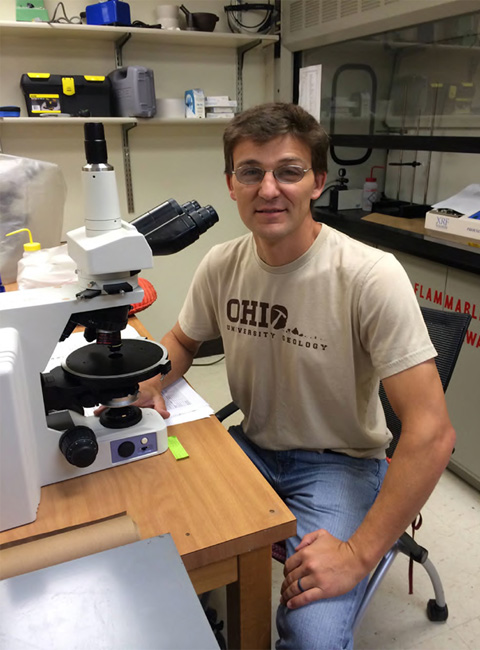October 2014 Geological Sciences Newsletter
Dr. Craig Grimes joined the faculty at Ohio University in Fall 2012 and is looking forward to the start of his third year on campus. He comes to OHIO with a B.S. in Geological Sciences from The Ohio State University (2003) and a Ph.D. in Geology from the University of Wyoming (2008), postdoctoral research at the University of Wisconsin-Madison (2008-09), and a tenure-track faculty position (Assistant Professor) at Mississippi State University (2009–12). His expertise covers the area of Igneous Petrology, Stable and Radiogenic Isotope Geochemistry, and Tectonics.
Here at OHIO he is teaching courses on Earth Materials and Resources, Igneous and Metamorphic Petrology, Isotope Geochemistry, and Ore Geology. He also co-taught the western portion of Field Camp along with Doug Green this past summer, and he will teach it again next summer with Damian Nance.
Grimes has carried out research in the Antarctic, as a shipboard scientist aboard the JOIDES Resolution on the Mid-Atlantic Ridge, the Mohave Desert, and in the Southern Appalachians of Alabama and Georgia. He is currently funded by the National Science Foundation on two projects: “Geochemical Imaging of Post-Pangean Lithospheric Structure in the Southern Appalachians” in collaboration with researchers at the University of Florida, and “Constraints on initiation of low-angle normal faults within the seismogenic regime” in collaboration with researchers at the University of Wyoming. These projects have funded the research of three Ohio University alumni including Christine Thomas (M.S., 2013); Jackson Reeder (B.S. Environmental Geology, 2013), and Cody MacDonald (M.S., 2014), and two current M.S. students now in their second year.
His research interests focus on fundamental igneous and tectonic processes that lead to the formation of oceanic and continental crust, past and present. Recent projects have examined magmatism and faulting in extensional tectonic settings (Mid-Atlantic Ridge & Mojave Desert), crustal source rocks for the most ancient (>4 Ga detrital zircons) geologic materials known from the Earth, the petrogenesis of silicic rocks recovered from modern ocean crust and ophiolites, and the origin of the Suwannee Terrane (southern Georgia, Florida) during amalgamation of Pangea. On the continents, His group is currently focused on field and lab-based studies to understand the initiation and slip of low-angle normal faults active during crustal extension.
The goals of this project are to establish fault geometry, constrain slip mechanisms, and evaluate field evidence for paleoseismicity. In addition to field investigations, students working in this group use a diverse set of analytical tools to collect their data, ranging from petrographic microscopes to Scanning Electron Microscopy (SEM), X-ray Fluorescence (XRF) Spectrometry, and Secondary Ion Mass Spectrometry (SIMS).



















Comments